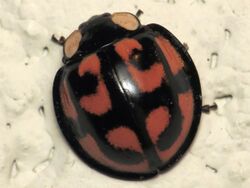Biology:Aiolocaria hexaspilota
| Aiolocaria hexaspilota | |
|---|---|

| |
| Adult Aiolocaria hexaspilota | |
| Scientific classification | |
| Kingdom: | |
| Phylum: | |
| Class: | |
| Order: | |
| Family: | |
| Subfamily: | |
| Tribe: | Coccinellini
|
| Genus: | Aiolocaria (Crotch, 1871)
|
| Species: | A. hexaspilota
|
| Binomial name | |
| Aiolocaria hexaspilota (Hope, 1831)
| |
| Synonyms | |
| |
Aiolocaria hexaspilota is a beetle species from the lady beetle family (Coccinellidae); adults can be as large as 13mm long. The species’ scientific name was first given in an 1831 publication by Frederick William Hope.[1] Unaware of its previous identification, Victor Motschulsky was later to call the same species as Aiolocaria mirabilis (in 1860). In most cases of such synonymy, according to the Encyclopedia of Life, “the first name takes priority and is considered to be the valid or accepted name.”[2]
Entomologists Ivo Hodek[3] (Czech Institute of Entomology) and Edward W. Evans[4] (Utah State University) describe the species as “a specialized predator of chrysomelids.”[5] Entomologist G. I. Savoiskaya has observed Aiolocaria hexaspilota actively pursuing larval prey.[6]
Ivo Hodek has also described the species as univoltine (having one brood per year); in early autumn they migrate from sun-exposed forest habitat “to well-insolated slopes of rocky hills or also to buildings.” Seeking winter shelter in rocky crevices or, opportunistically, in human dwellings, the beetles will cluster in aggregations of up to several hundred individuals. Hodek notes that by clustering together they maintain a temperature “much higher than ambient” and that in the spring the adults mate and disperse.[7]
References
- ↑ Joel K. Hallan, Synopsis of the described Coleoptera of the World , 6 June 2010. Accessed 19 May 2014.
- ↑ Aiolocaria hexaspilota, Encyclopedia of Life. Accessed 17 May 2014.
- ↑ Ivo Hodek, Institute of Entomology, Biology Centre, Academy of Sciences, Ceské Budejovice, Czech Republic. Accessed 19 May 2014.
- ↑ Edward (Ted) W. Evans, College of Science, Utah State University, Logan, Utah. Accessed 19 May 2014.
- ↑ Ivo Hodek, Edward W. Evans (2012) “Food relationships,” pp. 141-274, in I. Hodek, H. F. van Emden, A. Honěk (eds): Ecology and Behaviour of the Ladybird Beetles (Coccinellidae), West Sussex, UK: Wiley-Blackwell. ISBN:978-1-4051-8422-9, page 167.
- ↑ G. I. Savoiskaya (1970). “Coccinellids of the Alma-Ata reserve” in ‘’Trudy Alma-Atin. Gos. Zapov.’’ 9: pp. 163–187. (In Russian), cited in Ecology and Behaviour of the Ladybird Beetles (Coccinellidae), page 221.
- ↑ Ecology and Behaviour of the Ladybird Beetles (Coccinellidae), page 311.
Wikidata ☰ Q1860328 entry

